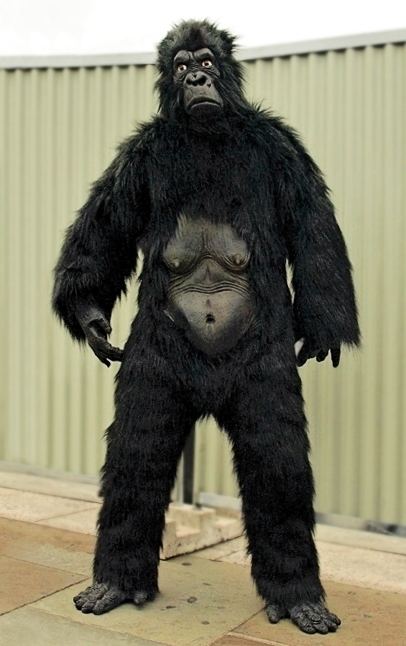 | ||
Gorilla suits are a type of creature suit resembling a gorilla. The gorilla suit is a popular Halloween and costume party costume, and is also used as a source of humour, while more realistic suits have been used both to represent real gorillas in film and on stage.
Contents
History
In 1869, Noah Brooks' short story, "Mr. Columbus Coriander's Gorilla" appeared in Bret Harte's Overland Monthly Magazine. The story concerned a young man employed at a menagerie dressed in a gorilla suit. It is mistakenly credited to Max Adeler.
In film, gorillas are often portrayed by actors in gorilla suits. The 1918 silent film Tarzan of the Apes has the first known instance of an ape suit, worn by an uncredited actor. The early history of the art of gorilla impersonation saw the rise of Charles Gemora in the late 1920s, an early practitioner of the art in such short films as Circus Lady and the Our Gang entry Bear Shooters. Gemora's original gorilla suit was hand-made and stuffed with kapok. In later decades, in addition to abounding in the Ape Woman films (consisting of Captive Wild Woman, Jungle Woman, and The Jungle Captive) and B movies such as Bela Lugosi Meets a Brooklyn Gorilla. Other noted Hollywood gorilla performers were George Barrows, Steve Calvert, Ray Corrigan, and Emil Van Horn.
In recent decades, the work of performers or designers have altered the mechanics and effect of gorilla suits, often using animatronics, taxidermy eyes, realistic fur, and other aides. Jim Henson utilized typical gorilla suits and even a full-bodied gorilla Muppet in several productions (like in Time Piece, The Cube, some episodes of Sesame Street, and the "Avery Schreiber" episode of The Muppet Show). The person inside the gorilla suit is often uncredited. Jim Henson's Creature Shop has contributed to this development in its own way, through work on Buddy, George of the Jungle, and MirrorMask. Many suit performers of Jim Henson's characters portrayed gorillas in other productions.
Gorilla suits and masks are also used to disguise their wearer. Members of the feminist artist group Guerrilla Girls maintain their anonymity by wearing gorilla masks for their public appearances. In an effort to avoid reporters, Boston Red Sox manager Theo Epstein donned a gorilla suit when he left Fenway Park after announcing his resignation in 2005.
During the annual Great Gorilla Runs held in North American and British cities, runners in gorilla suits take part in an eight kilometre fun run to raise money for The Gorilla Organization. The event started in 2003 in London. Finnish racing driver Kimi Räikkönen was part of a gorilla-suited motorboat race crew in 2007 and attends parties in his gorilla suit.
National Gorilla Suit Day
In 1963, Don Martin published National Gorilla Suit Day in a collection Don Martin Bounces Back, in which Fester Bestertester mocks the (then fictitious) concept of a National Gorilla Suit Day, and suffers a series of incredible assaults from gorillas and other creatures in gorilla and other suits.
Subsequently, Don Martin fans have celebrated National Gorilla Suit Day on January 31.
Gorillagrams
A gorillagram is a gift message, similar to a singing telegram, but delivered by a performer dressed in a gorilla suit.
